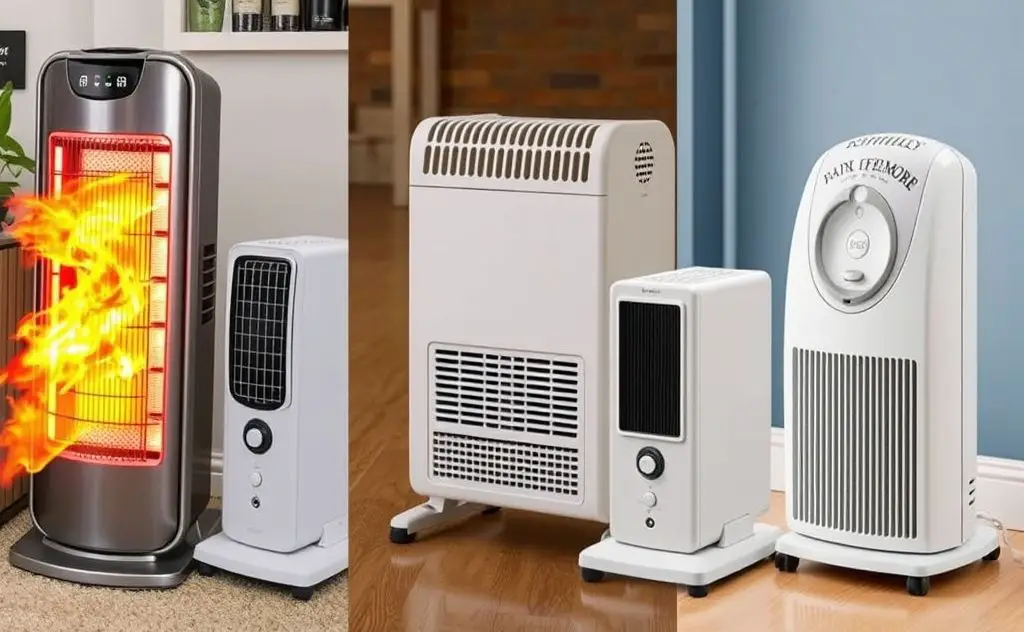Electric heaters work by converting electrical energy into heat through various methods, including resistance heating in convective heaters, radiant heating in infrared models, and heat pumps that transfer thermal energy from the environment, efficiently warming spaces as needed.
Electric heaters transform electricity into heat through various technologies, each with unique advantages for different spaces. From radiant coils to oil-filled radiators, understanding how these devices work helps you choose the right heating solution.

Core Heating Technologies in Electric Heaters
Resistive Heating Elements
Most electric heaters use nichrome wire coils that heat up when electricity passes through. This resistance heating principle converts nearly 100% of electrical energy into heat. The ceramic heating elements in modern heaters work similarly but distribute heat more evenly.
Heat Pumps (Not Pure Electric Heaters)
While often grouped with electric heaters, heat pumps don’t generate heat directly. They move existing thermal energy using refrigeration cycles, achieving 150-600% efficiency (COP 1.5-6.0). These systems require outdoor units and refrigerant lines.

Main Types of Electric Space Heaters
Radiant Heaters
These heaters use glowing coils or quartz tubes to emit infrared radiation that warms objects directly. Key features:
- Instant heat sensation
- Silent operation
- Best for spot heating
- Higher surface temperatures (safety consideration)
The quartz infrared heaters represent an advanced version of this technology.
Convection Heaters
These heaters warm air that circulates naturally or via fans:
| Type | Heating Method | Best For |
|---|---|---|
| Natural Convection | Passive air movement | Quiet spaces |
| Fan Heaters | Forced air circulation | Quick heating |
Oil-Filled Radiators
These sealed units heat diathermic oil that retains warmth for hours after turning off. Compared to standard electric heaters, they provide more consistent heat but take longer to warm up.
Specialized Electric Heating Systems
Baseboard Heaters
Installed along walls, these use natural convection to create a “thermal curtain” effect. Modern versions feature precise thermostats and sleek designs that blend with room decor.
Cove Heating Systems
Mounted near ceilings, these radiant panels warm rooms from above while saving floor space. They’re particularly effective in rooms with high ceilings where heat stratification occurs.
Energy Efficiency Considerations
While all electric heaters convert nearly 100% of electricity to heat, their effective efficiency varies:
- Radiant heaters feel warmer at lower air temperatures
- Oil-filled units maintain heat longer after cycling off
- Ceramic heaters respond quickly to thermostat changes
According to U.S. Department of Energy, proper sizing and placement significantly impact real-world efficiency.
Safety Features in Modern Electric Heaters
Contemporary models include multiple protections:
- Tip-over switches
- Overheat protection
- Cool-touch exteriors
- Thermal fuses
The safety precautions for ceramic heaters apply to most electric heating devices.
Choosing the Right Heater for Your Space
Consider these factors when selecting an electric heater:
| Room Type | Recommended Heater | Reason |
|---|---|---|
| Bedroom | Oil-filled radiator | Quiet, consistent heat |
| Workshop | Radiant heater | Spot heating capability |
| Living Room | Ceramic tower heater | Even heat distribution |
For whole-house heating, the Consumer Reports buying guide suggests considering heat pumps rather than multiple space heaters.
